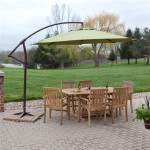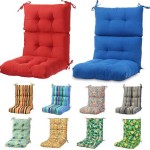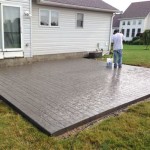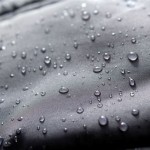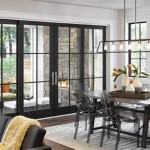Does Patio Furniture Need To Be Covered In The Winter Season?
The question of whether to cover patio furniture during the winter months is a common one for homeowners and businesses alike. The answer isn't a simple yes or no, as it depends on several factors, including the type of furniture, the climate in which it is stored, and the level of protection desired. Leaving patio furniture exposed to the elements during the winter can lead to a range of problems, from cosmetic damage to significant structural deterioration. Understanding the potential risks and benefits of covering patio furniture is crucial for preserving its longevity and maintaining its aesthetic appeal.
Winter weather presents a unique set of challenges for outdoor furniture. Snow, ice, rain, and fluctuating temperatures can all contribute to the degradation of various materials. Prolonged exposure to moisture can lead to rust in metal furniture, cracking in wood, and fading or mildew growth on fabrics. The freeze-thaw cycle, in particular, can be detrimental, as water that penetrates porous materials expands when frozen, causing cracks and weakening the overall structure. Furthermore, high winds can damage uncovered furniture, potentially blowing it around and causing collisions with other objects or even property damage. Ultra-violet (UV) radiation, though less intense in winter, can still contribute to gradual fading and discoloration, especially for brightly colored fabrics and plastics.
However, simply covering patio furniture without proper consideration can also lead to problems. Trapped moisture under a cover can create a humid environment, promoting mold and mildew growth. Poorly ventilated covers can also trap condensation, exacerbating the effects of moisture damage. The type of cover used is critical; a breathable, water-resistant cover is generally preferable to a completely waterproof one, as it allows for air circulation while still protecting against rain and snow. Furthermore, the method of covering the furniture should be considered. Ensuring proper fit and secure fastening can prevent the cover from being blown off in high winds, while also allowing for adequate ventilation.
Understanding the Material Composition of Your Patio Furniture
The material composition of patio furniture is a primary determinant of its susceptibility to winter damage. Different materials react differently to the elements, and understanding these reactions is crucial for deciding whether covering is necessary and, if so, what type of cover is most appropriate.
Wood Furniture: Wood, particularly unfinished wood, is highly susceptible to moisture damage. Water absorption can lead to swelling, warping, and cracking. The freeze-thaw cycle is especially damaging to wood, as water trapped within the wood fibers expands upon freezing, causing structural damage. Even treated wood can be affected over time, as the protective coatings wear away. Covering wood furniture is generally recommended to protect it from direct exposure to rain and snow. However, it's equally important to ensure proper ventilation to prevent moisture buildup under the cover. Teak and cedar, known for their natural resistance to decay, may require less stringent covering protocols than softer woods like pine.
Metal Furniture: Metal furniture, especially iron and steel, is prone to rust when exposed to moisture. Rust can weaken the structural integrity of the furniture and detract from its appearance. While powder-coated metal furniture offers some protection against rust, scratches and chips in the coating can expose the underlying metal to corrosion. Aluminum furniture is less susceptible to rust, but it can still corrode over time, especially in coastal environments with high salt content. Covering metal furniture can significantly reduce the risk of rust formation. Applying a rust-inhibiting spray before covering can provide an extra layer of protection.
Wicker and Rattan Furniture: Wicker and rattan furniture, whether natural or synthetic, can be damaged by moisture and extreme temperatures. Natural wicker and rattan are particularly vulnerable to mold and mildew growth, as well as cracking and splitting in cold weather. Synthetic wicker, made from materials like resin or PVC, is more durable than natural wicker, but it can still become brittle and crack in freezing temperatures. Covering wicker and rattan furniture is recommended to protect it from moisture and temperature extremes. Storing this type of furniture in a dry, sheltered location, such as a garage or shed, is an even better option.
Plastic and Resin Furniture: Plastic and resin furniture are relatively durable and resistant to moisture damage. However, prolonged exposure to UV radiation can cause fading and discoloration. Extreme cold can also make plastic and resin brittle, increasing the risk of cracking. Covering plastic and resin furniture can help to protect it from UV damage and prevent it from becoming brittle in cold weather. However, it's important to choose a breathable cover to prevent condensation buildup.
Upholstered Furniture: Upholstered furniture, including cushions and pillows, is particularly susceptible to moisture damage and mildew growth. Even water-resistant fabrics can become saturated over time, leading to mold and mildew formation. The stuffing inside cushions can also absorb moisture, making them heavy and uncomfortable. Storing upholstered furniture indoors during the winter is the best way to protect it. If indoor storage is not possible, covering the furniture with a waterproof cover is essential. However, it's important to remove the cushions and pillows from the furniture and store them separately in a dry location.
Evaluating Your Local Climate
The geographic location and the prevailing climate play a crucial role in determining whether covering your patio furniture is necessary. Areas with harsh winters characterized by heavy snowfall, frequent freezing rain, and prolonged periods of sub-freezing temperatures will pose a greater threat to outdoor furniture than regions with milder winters.
Snowfall and Ice: Heavy snowfall can place significant weight on patio furniture, potentially causing structural damage. Ice accumulation can also contribute to damage by trapping moisture and exacerbating the effects of the freeze-thaw cycle. In areas with heavy snowfall, covering patio furniture with a sturdy, waterproof cover is highly recommended. The cover should be able to withstand the weight of the snow without tearing or collapsing. Regular removal of accumulated snow from the cover can also help to prevent damage.
Rain and Humidity: Frequent rainfall and high humidity can create a breeding ground for mold and mildew, especially if patio furniture is not properly ventilated. In areas with high rainfall and humidity, covering patio furniture with a breathable, water-resistant cover is essential. The cover should allow for air circulation while still protecting against rain. Regularly inspecting the furniture for signs of mold and mildew and cleaning it as needed can also help to prevent damage.
Temperature Fluctuations: Extreme temperature fluctuations, particularly the freeze-thaw cycle, can be particularly damaging to patio furniture. As discussed earlier, the expansion and contraction of water within porous materials can cause cracks and weakening of the structure. In areas with significant temperature fluctuations, covering patio furniture with a cover that provides insulation can help to minimize the effects of the freeze-thaw cycle. Storing the furniture in a sheltered location, such as a garage or shed, is an even better option.
Wind: High winds can cause significant damage to uncovered patio furniture, potentially blowing it around and causing collisions with other objects or property. In windy areas, securing patio furniture is essential, whether by covering it or storing it indoors. Covers should be securely fastened to prevent them from being blown off. Weighing down furniture with sandbags or other heavy objects can also help to prevent it from being blown around.
UV Exposure: Though often associated with summer, UV radiation can still contribute to fading and discoloration during the winter months, particularly in areas with clear skies and reflective surfaces like snow. While winter UV intensity is generally lower than summer, prolonged exposure can still impact the appearance of patio furniture. Covering furniture, especially those with brightly colored fabrics or plastics, can help mitigate this effect. Consider covers with UV-resistant properties for added protection.
Choosing and Using the Right Patio Furniture Covers
Selecting the appropriate type of cover and utilizing it correctly is paramount for optimal winter protection. A poorly chosen or improperly used cover can actually exacerbate damage rather than prevent it.
Material Considerations: The material of the cover is a crucial factor. Breathable, water-resistant fabrics like polyester with a waterproof coating or specialized outdoor fabrics are generally preferable to completely waterproof covers like vinyl. Breathable covers allow moisture to escape, preventing condensation buildup and reducing the risk of mold and mildew growth. Waterproof covers, while providing excellent protection against rain and snow, can trap moisture if not properly ventilated. Consider the specific material of your patio furniture when selecting a cover. For wood furniture, a breathable cover is especially important. For metal furniture, a waterproof cover with rust-inhibiting properties may be a better choice.
Fit and Design: The cover should fit the furniture snugly, but not so tightly that it restricts airflow. A loose-fitting cover can be blown off in high winds or allow snow and rain to accumulate inside. Many covers come with adjustable straps, buckles, or drawstrings to ensure a secure fit. Look for covers that are specifically designed for your type of furniture, such as chair covers, table covers, or sectional covers. These covers will provide a better fit and offer more complete protection. Covers with vents can also help to improve air circulation and prevent condensation.
Proper Application and Maintenance: Before covering patio furniture, clean it thoroughly to remove any dirt, debris, or stains. Allow the furniture to dry completely before covering it to prevent moisture buildup. Elevating furniture slightly off the ground using furniture risers or blocks can also improve air circulation and reduce the risk of moisture damage. Regularly inspect the covers for tears, holes, or other damage and repair them promptly. Clean the covers periodically with a mild soap and water solution to remove dirt and mildew. Store the covers in a dry location when not in use to prevent damage.
Alternative Solutions: If covering patio furniture is not feasible or desirable, consider alternative solutions, such as storing the furniture indoors or in a sheltered location. Garages, sheds, and basements provide excellent protection from the elements. If indoor storage is not possible, moving the furniture to a covered porch or patio can provide some protection. Applying protective coatings, such as wood sealants or rust-inhibiting sprays, can also help to protect patio furniture from the elements. Consider the long-term cost and effort associated with each option when making your decision.
Ultimately, the decision of whether to cover patio furniture during the winter depends on a careful assessment of the furniture's material, the local climate, and the available storage options. While covering patio furniture can provide significant protection against the elements and extend its lifespan, it's crucial to choose the right type of cover and use it properly to avoid exacerbating damage. By understanding the potential risks and benefits, homeowners and businesses can make informed decisions that will help them preserve the beauty and functionality of their outdoor furniture for years to come.

Winterproofing Your Outdoor Furniture Easy Tips

How To Outdoor Furniture For Winter Protect Your Patio

Should You Cover Your Patio Furniture In The Winter Kool Breeze Inc

Covering Your Patio Furniture For Winter Weather

What To Do With Your Outdoor Patio Furniture During Winter Torva

How You Can Protect Patio Furniture During Winter

How Do You Cover Patio Furniture For Winter New Dawn Awning

How To Take Care Of Your Outdoor Patio Furniture This Winter

Storing Patio Furniture In Winter National Storage

7 Tips To Transition Your Outdoor Space For Winters Covers All Blog
Related Posts

